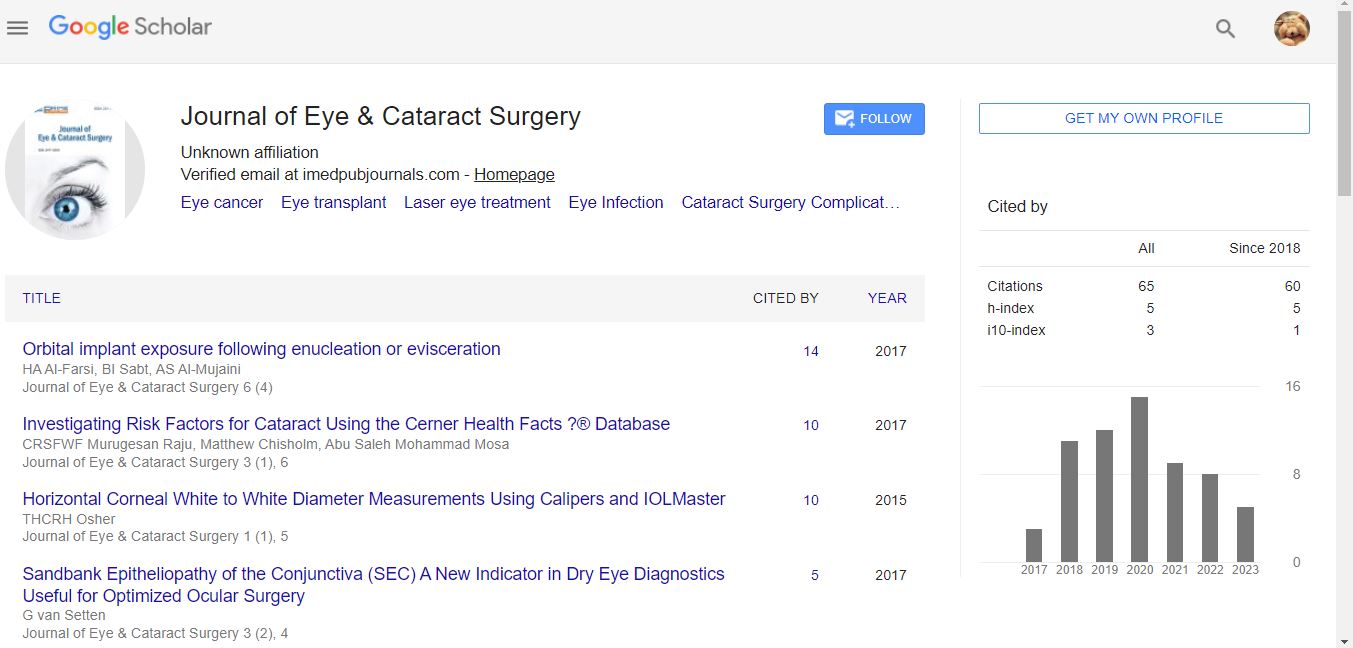Short Communication - (2024) Volume 10, Issue 2
Understanding Blindness: Causes, Impact, and Supportive Measures
Fanima Pamif*
Department of Ophthalmology, Columbia University, USA
*Correspondence:
Fanima Pamif,
Department of Ophthalmology, Columbia University,
USA,
Email:
Received: 29-May-2024, Manuscript No. IPJECS-24-20642;
Editor assigned: 31-May-2024, Pre QC No. IPJECS-24-20642 (PQ);
Reviewed: 14-Jun-2024, QC No. IPJECS-24-20642;
Revised: 19-Jun-2024, Manuscript No. IPJECS-24-20642 (R);
Published:
26-Jun-2024, DOI: 10.36648/2471-8300.10.2.11
Introduction
Blindness is a profound visual impairment that significantly
impacts an individual’s quality of life, independence, and
daily activities. It can be caused by various factors, ranging
from congenital conditions to acquired diseases or injuries. In
this article, we’ll explore the causes, impact, and supportive
measures for individuals affected by blindness. Blindness can
result from different underlying conditions affecting the eyes
or visual pathways. Some common causes include: Clouding
of the eye’s natural lens, leading to progressive vision loss
if left untreated. Damage to the optic nerve, often due to
increased pressure within the eye, resulting in gradual vision
loss. Degeneration of the macula, the central part of the retina,
causing loss of central vision [1,2].
Description
Damage to blood vessels in the retina due to diabetes, leading
to vision impairment or blindness if untreated. Separation of the
retina from its underlying supportive tissue, resulting in sudden
vision loss. Conditions affecting the optic nerve, such as optic
neuritis or ischemic optic neuropathy. Certain infections, like
trachoma, onchocerciasis (river blindness), or cytomegalovirus
(CMV) retinitis, can cause blindness if left untreated. Severe eye
injuries or trauma to the head can lead to irreversible vision loss.
Blindness profoundly impacts individuals physically, emotionally,
and socially: Blindness can make simple tasks, such as navigating
unfamiliar environments, cooking, or using technology,
challenging without assistance. Adjusting to life with vision
loss can lead to feelings of frustration, anxiety, or depression.
Difficulty participating in social activities or maintaining
relationships due to communication barriers. Blindness may
limit employment opportunities and access to education
without appropriate support and accommodations. Despite the
challenges posed by blindness, various supportive measures
and rehabilitation services can help individuals adapt and thrive:
Learning techniques to navigate safely using a white cane, guide
dog, or assistive technologies. Developing skills for independent
living, including cooking, grooming, and using adaptive devices.
Learning strategies to maximize existing vision and adapt to
visual impairment. Using specialized devices like screen readers,
magnifiers, or voice-activated tools to access information and
communicate. Accessing resources for education, vocational
training, or job placement tailored to individuals with visual
impairments. Counseling, peer support groups, or community
organizations providing emotional and social support for
individuals and their families. While not all causes of blindness
are preventable, certain preventive measures can reduce the
risk of vision loss: Regular eye exams to detect and treat eye
conditions early. Managing systemic health conditions like
diabetes or hypertension. Protecting the eyes from trauma or
injury using appropriate safety measures. Avoiding smoking and
maintaining a healthy lifestyle [3,4].
Conclusion
Advances in medical technology and research offer hope for
individuals with vision loss. Innovative treatments such as
gene therapy, stem cell therapy, and retinal implants are being
explored to restore vision or prevent further deterioration in
certain conditions. Blindness is a life-altering condition with
diverse causes and profound implications for affected individuals.
While vision loss presents significant challenges, comprehensive
support services, rehabilitation, and advancements in
technology contribute to improving quality of life and enabling
independence. By raising awareness, advocating for accessibility,
and investing in research, we can empower individuals with
blindness to live fulfilling and inclusive lives, ensuring equal
opportunities and support for all members of our communities.
Acknowledgement
None.
Conflict Of Interest
None.
References
- Toh CJL, Liu C, Lee IXY, Lin MTY, Tong L, et al. (2023) Clinical associations of corneal neuromas with ocular surface diseases. Neural Regen Res. 19(1):140-147.
[Crossref] [Google Scholar] [PubMed]
- Cao B, Vu CHV, Keenan JD (2023) Telemedicine for cornea and external disease: A scoping review of imaging devices. Ophthalmol Ther. 12(5):2281-2293.
[Crossref] [Google Scholar] [PubMed]
- Sheppard J, Lee BS, Periman LM (2023) Dry eye disease: Identification and therapeutic strategies for primary care clinicians and clinical specialists. Ann Med. 55(1):241-252.
[Crossref] [Google Scholar] [PubMed]
- Zheng Y, Baidya A, Annabi N (2023) Molecular design of an ultra-strong tissue adhesive hydrogel with tunable multifunctionality. Bioact Mater. 29:214-229.
[Crossref] [Google Scholar] [PubMed]
Citation: Pamif F (2024) Understanding Blindness: Causes, Impact, and Supportive Measures. J Eye Cataract Surg. 10:11.
Copyright: © 2024 Pamif F. This is an open-access article distributed under the terms of the Creative Commons Attribution Li�cense, which permits unrestricted use, distribution, and reproduction in any medium, provided the original author and source
are credited.

